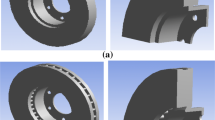Abstract
In a disc brake system, thermal expansion of the material is caused by friction energy that is generated by the sliding contact between a disc and pad during braking. This phenomenon, thermo-elastic instability, can lead to hot spots on the disc surface and a hot judder phenomenon. Transient finite element analysis has been used to simulate this phenomenon. Three dimensional finite element models of a disc, pad, and cylinder were created. Each part was connected by a joint. Contact condition was applied to the disc and pad with a friction coefficient (μ) of 0.4. A convective heat transfer coefficient was set as 40 W/m2K. Using a commercial program SAMCEF, the simulation of the thermo-mechanically coupled system was performed. In order to find the sensitive parameters of brake judder, sensitivity analysis was carried out with consideration for disc design parameters. As a result, the hot spot phenomenon was confirmed and hot judder was predicted. Moreover, the more sensitive parameters of the hot judder phenomenon were presented. Finally, an improved disc model and an analysis technique were verified by comparison to dynamo test results.
Similar content being viewed by others
References
Altuzarra, O., Amezua, E., Avilés, R. and Hernández, A. (2002). Judder vibration in disc braked excited by thermoelastic instability. Engineering Computations: Int. J. Computer-Aided Engineering 19,4, 411–430.
Cho, H. J., Kim, M. G. and Cho, C. D. (2007). A study of frictional contact vibration influence on hot spot in automotive disk brake. Trans. Korean Society of Automotive Engineers 15,1, 154–161.
Faramarz, T. and Salman, J. (2009). Analysis of heat conduction in a disc brake system. Heat and Mass Transfer 45,8, 1047–1059.
Geradin, M. and Cardona, A. (2000). Flexible Multibody Dynamics: A Finite Element Approach. John Willey & Sons. New York.
Jung, S. P. and Park, T. W. (2008). Development of the optimization design module of a brake system. Trans. Korean Society of Automotive Engineers 16,3, 166–171.
Jung, S. P., Park, T. W., Chai, J. B. and Chung, W. S. (2011). Thermo-mechanical finite element analysis of hot judder phenomenon of a ventilated disc brake system. Int. J. Precision Engineering and Manufacturing 12,5, 821–828.
Kim, M. G. and Cho, C. (2006). Critical speed analysis of judder due to change in surface temperature of disc brake. Int. J. Automotive Technology 7,6, 697–702.
Kim, S. H., Han, E. J., Kang, W. S. and Cho, S. S. (2008). Investigation of influential factors of a brake corner system to reduce brake torque variation. Int. J. Automotive Technology 9,2, 233–247.
Kim, S. M. (2009). A study on thermal analysis in ventilated disk brake by FEM. J. Korean Society of Machine Tool Engineers 18,5, 544–549.
Kim, Y. G., Kim, S. W., Park, C. K., Park, T. W. and Kim, Y. M. (2011). Measurement of the disc-pad friction coefficient for mechanical brakes using direct and indirect methods. Int. J. Automotive Technology 12,1, 51–58.
Lee, K. J. and Barber, J. R. (1994). An experimental investigation of frictionally-excited thermoelastic instability in automotive disk brakes under a drag brake application. J. Tribology, 116, 409–414.
Plackett, R. L. and Burman, J. P. (1946). The dessign of optimum multifactorial experiments. Biometrica 33,4, 305–325.
SAMTEC (2010). SAMCEF User’s Manual. Ver.13.1. SAMTEC. Liège. Belgium.
Song, B. C., Kang, D. H., Kim, Y. H., Park, Y. C. and Lee, K. H. (2007). Structural design of a circumferential friction disc-brake, considering thermoelastic instability. J. Korean Society of Manufacturing Process Tool Engineer 6,3, 38–46.
Yoon, G. H. and Sigmund, O. (2008). A monolithic approach for topology optimization of electrostatically actuated devices. Computer Methods in Applied Mechanics and Engineering, 197, 4062–4075.
Zagrodzki, P., Lam, K. B., Albahkali, E. and Barber, J. R. (2001). Nonlinear transient behavior of a sliding system with frictionally excited thermoelastic instability. J. Tribology 123,4, 699–708.
Author information
Authors and Affiliations
Corresponding author
Rights and permissions
About this article
Cite this article
Park, J.H., Park, T.W., Lee, J.H. et al. Hot judder simulation of a ventilated disc and design of an improved disc using sensitivity analysis. Int.J Automot. Technol. 15, 1–6 (2014). https://doi.org/10.1007/s12239-014-0001-2
Received:
Revised:
Accepted:
Published:
Issue Date:
DOI: https://doi.org/10.1007/s12239-014-0001-2



